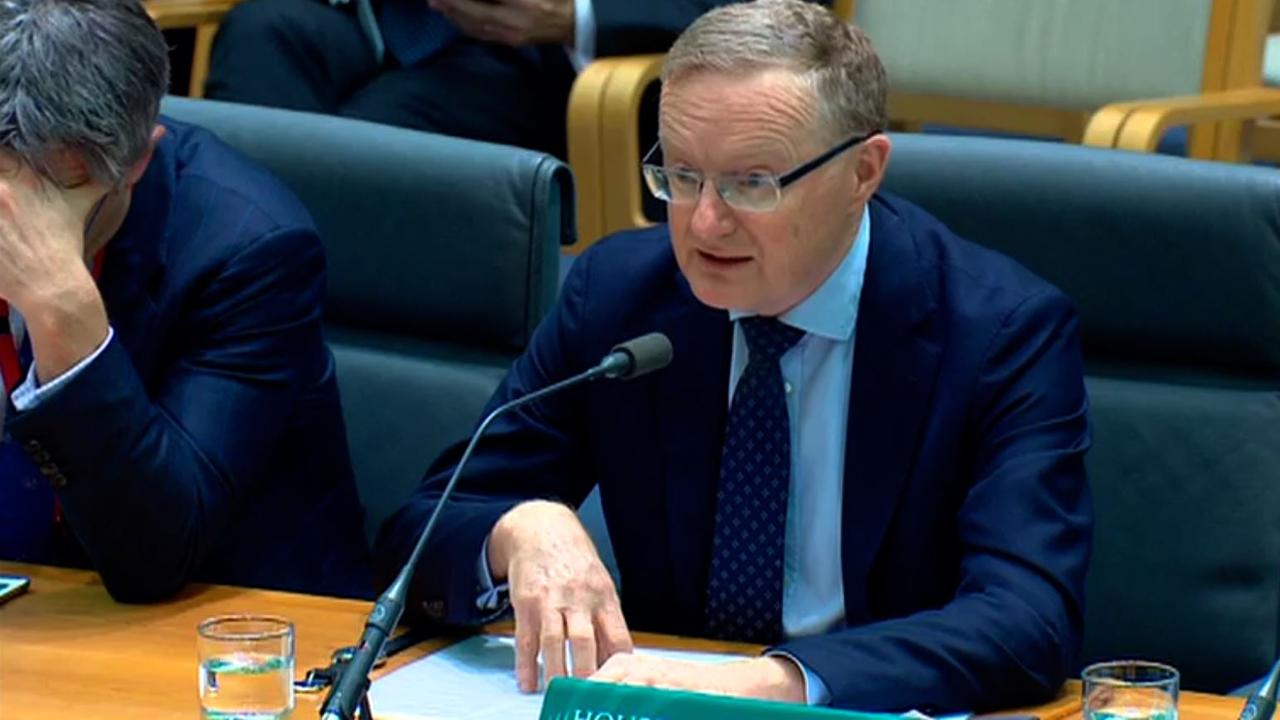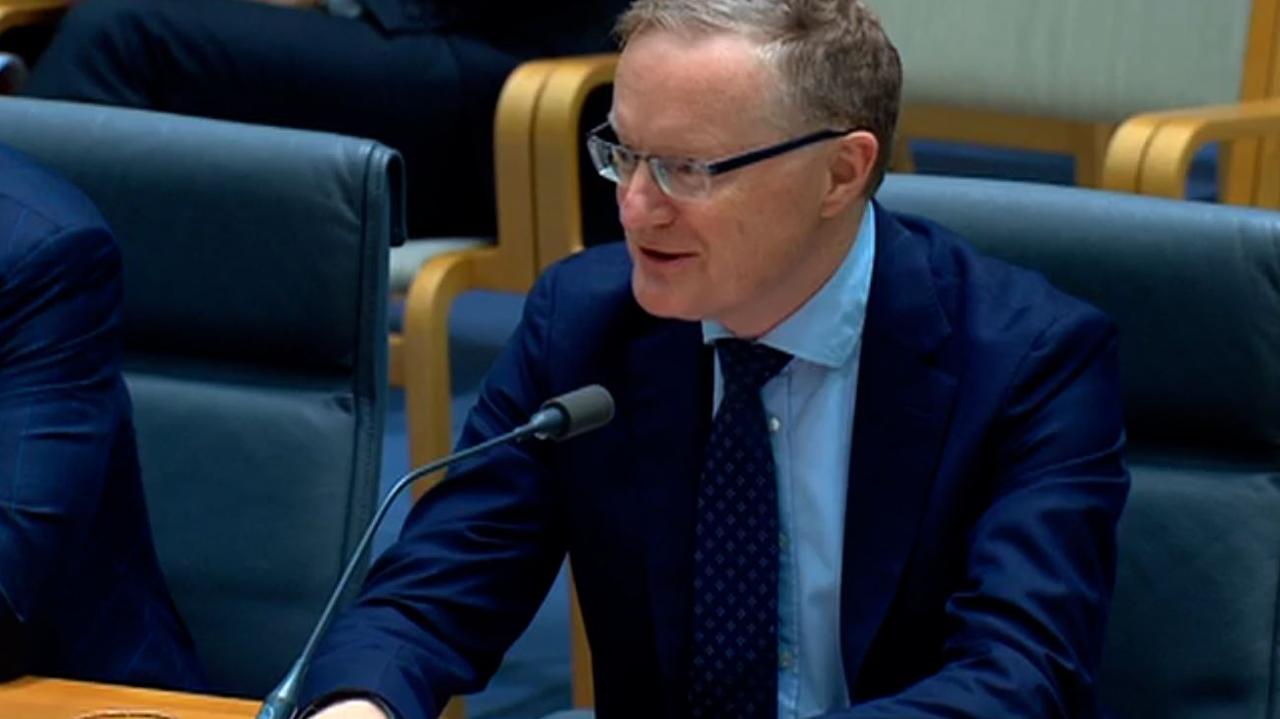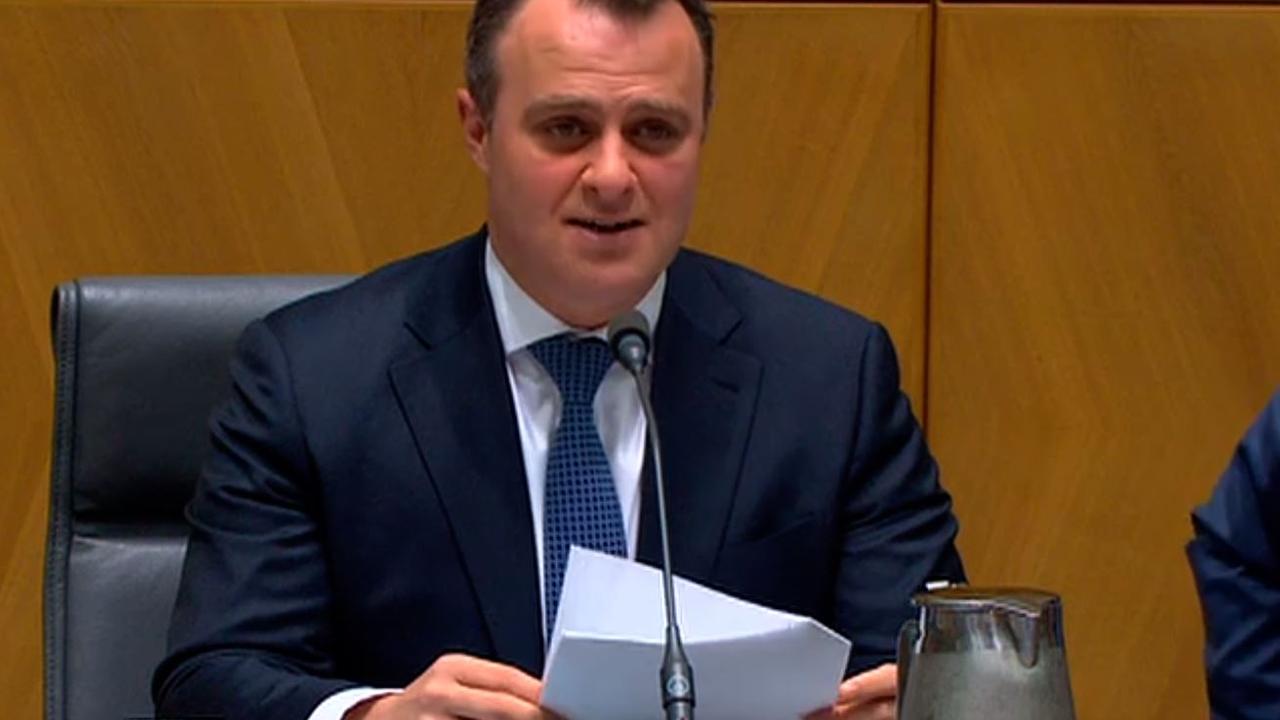RBA Governor Philip Lowe appears before parliamentary committee in Canberra
RBA boss Philip Lowe says the Australian economy is at a “turning point” - and he has delivered a veiled message to the government.
Reserve Bank Governor Philip Lowe has issued a thinly veiled message to the government - please do more.
Dr Lowe told the government’s Economics Committee in Canberra this morning the Australian economy was at a “turning point”, as he outlined the RBA’s latest forecasts.
Those forecasts include a prediction that economic growth will be lower than previously expected. The RBA now predicts GDP growth of 2.5 per cent this year, rising to 2.75 per cent next year.
Inflation will remain below the RBA’s target for some time, unemployment will stay above 5 per cent, and upward pressure on wage growth will continue to be “quite modest”.
Dr Lowe blamed the revisions on weak consumption growth at the domestic level and the “major uncertainty” internationally as a result of the trade war between China and the United States.
“It has become increasingly clear that the extended period of unusually slow growth in household incomes has been weighing on household spending,” he said.
He said caps on wage growth in the public sector were contributing to the problem, and a pick-up in wages would be “both affordable and desirable” - while conceding it was “a bit controversial” for him to say such things in public.
I can understand why governments are doing that (imposing wage caps), because it’s important they have budget discipline,” Dr Lowe said.
“On the other hand, the wage caps in the public sector are cementing low wage norms across the country. The norm is now 2-2.5 per cent, and largely that’s coming from the decisions being taken by the state governments.”

There is only so much the RBA itself can do to help. With the cash rate at a record low of 1 per cent, it has very little room to move.
With that in mind, Dr Lowe pushed the government to consider two possible methods to stimulate the economy - either more infrastructure spending, or structural policy changes.
“One option is for fiscal support, including through spending on infrastructure,” Dr Lowe said.
“Spending on infrastructure not only adds to demand in the economy but, done properly, it can boost the economy’s productivity. It can also directly improve the quality of people’s lives through reducing congestion and improving services.
“At the moment, there are some capacity constraints in parts of the infrastructure sector, but these should not prevent us from looking for further opportunities to boost the economy’s productive capacity and support domestic demand.
“There is no shortage of finance to do this, with interest rates the lowest they have ever been. This week, all governments in Australia can borrow for 10 years at less than 2 per cent.”
Hint, hint.
The other, structural approach would involve policy changes to support firms expanding, innovating and employing more people.
“It’s very much linked to the issue of productivity. What do we do to lift productivity growth in this country?” Dr Lowe said.
Productivity growth has dropped off sharply in recent years. Dr Lowe nominated a number of policy areas where improvements could be made, including the way land is taxed, the incentives for innovation and entrepreneurship in the tax system, competition policy, skills and education, and the use of data by government to drive better delivery of services.
“There’s no shortage of ideas across those various areas,” he said.
Asked whether increasing the Newstart allowance would help the economy, Dr Lowe confirmed it would increase aggregate demand. However he said that benefit had to be balanced against the cost to the federal budget.

The news wasn’t all negative. Dr Lowe cited lower interest rates, the recent tax cuts, the depreciation of the dollar, a brighter outlook for resources investment, high infrastructure investment and a correction in the housing market as positive factors for the economy.
“There are signs the economy may have reached a gentle turning point,” he said.
“We are expecting quarterly GDP growth outcomes to strengthen gradually after a run of disappointing numbers.
“It is reasonable to expect that, together, these factors will see growth in the Australian economy return to around its trend rate next year.”
But the situation has undeniably deteriorated since his last appearance before the committee earlier this year.
At that point, he told it the chances of the cash rate going up or down were roughly even. Since then, of course, the RBA has lowered the rate twice to a record low of 1 per cent.
“A reasonable question to ask is what changed? And the answer is the accumulation of evidence that the economy could be on a better path than the one we were on,” Dr Lowe said this morning.
He justified the decision to lower the cash rate, saying it would “boost jobs and help make more assured progress towards the inflation target”.
“I acknowledge that lower interest rates do hurt the finances of many Australians who rely on interest payments,” he conceded.
“(But) lower interest rates do put more money in the hands of the household sector in aggregate, and at some point this money will be spent.
“Concerning international developments could see the economy underperform our central scenario.
“While we might wish it were otherwise, it is difficult to escape the fact that if global interest rates are low, they are going to be low here in Australia too.”
Dr Lowe also defended the board’s decision to keep the rate on hold earlier this week.
“After having moved twice in quick succession, it was appropriate to wait and assess developments both internationally and domestically,” he said.
He warned the ongoing trade war posed a “significant risk” to the global and Australian economies.
“We have a lot riding on these disputes being resolved soon,” Dr Lowe said.
“Right around the world, there is an elevated desire to save and a depressed desire to invest.
“We’re really responding to this deep structural shift in the balance between savings and investment around the world, and there’s not much we can do about that.
“We can’t escape the fact that globally, interest rates are low.”

Dr Lowe’s appearance before the committee today comes amid accusations he has “thrown up his hands” and given up on stimulating the economy.
RELATED: Reserve Bank keeps cash rate on hold
Liberal MP Tim Wilson, who chairs the committee, yesterday said it seemed as though Dr Lowe had “said he has exhausted the options of monetary policy”.
Dr Lowe pushed back on that this morning, indicating the RBA could lower the cash rate to zero, and was also examining other policy options used by central banks overseas, including quantitative easing.
He said it was “unlikely” the RBA would actually pursue quantitative easing, but it was a “prudent” idea to consider.
Mr Wilson followed through on his promise to grill Dr Lowe on the wisdom of keeping interest rates at historic lows, citing concerns the policy could become less effective the longer those lows persisted.
“I wouldn’t accept the proposition that lowering interest rates is no longer effective at stimulating the economy. It’s just different than it used to be,” Dr Lowe said.
“In today’s environment people don't run off to the bank when interest rates fall. They’re more likely to pay down the mortgage.”
“There really are a lot of questions they need to answer about their decisions and what they’re factoring in,” Mr Wilson told the AFR yesterday.
“The consistency at times between what their own internal research is showing around the consequences of lower interest rates and the decision to cut interest rates is going to be a pretty heavy focus.
“They’re saying publicly at the moment that cutting rates won’t increase the amount of debt and house prices, but their own research shows cutting interest rates is the biggest contributor to the volume of household debt and house prices.”
The “internal research” to which Mr Wilson referred is a paper called A Model of the Australian Housing Market, which was written by RBA analysts Trent Saunders and Peter Tulip and published in March.
That paper found changes in interest rates were the most significant influence on house prices.
Today Dr Lowe said he was “not worried” rate cuts would lead to riskier home borrowing.
RELATED: Australian dollar falls to 10-year low
The global trend of cutting interest rates continued on Wednesday. The Reserve Bank of New Zealand slashed its own official cash rate by 50 basis points, citing weakened global activity as a result of the trade war between the United States and China.
Shortly afterwards, the Australian dollar plummeted to its lowest level since 2009, when the Global Financial Crisis ramped up.
Earlier this week, former prime minister John Howard warned the RBA may have already cut interest rates “too far”, leaving Australia lacking ammunition in the event of another global shock.
Speaking to the ABC, Mr Howard said he was “not sure that these interest rate cuts have been the right thing to do”.
“But I don’t think my advice will be taken. A number of reasons why we came through the GFC so well is that our interest rates were higher when we entered the GFC and the central bank had room to move”.
“If you cut them too far you get rid of all that petrol in the tank. If something unexpected comes along, you don’t have the same room to manoeuvre. It’s a point of view, and I’m not claiming any special expertise, but I think we’ve gone quite far enough and perhaps too far.”




